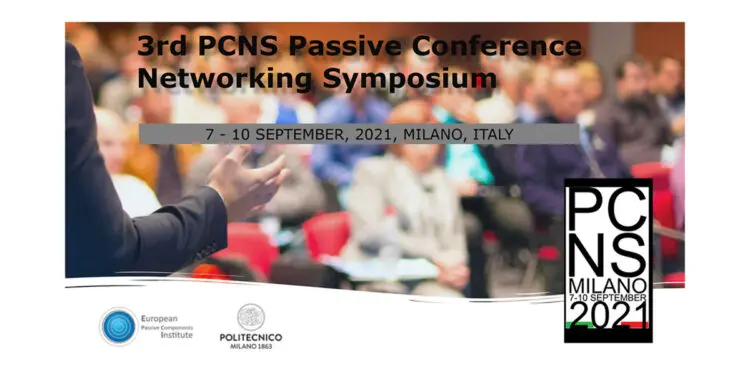PCNS Passive Components Networking Symposium organizing committee is pleased to announce Call for Papers for the 3rd international symposium dedicated to passive components. The event will be held on September 7th to 10th 2021 in Milano, Italy hosted by Politecnico di Milano university.
PCNS Passive Components Networking Symposium is a bi-annual international symposium organized by EPCI European Passive Components Institute in co-operation with an European university. 3rd edition of the PCNS Passive Components Networking Days Symposium is hosted by Department of Chemistry, Materials and Chemical Engineering “Giulio Natta” and Department of Electronics, Information and Bioengineering Faculty of Politecnico di Milano.
3rd PCNS is intended as a hybrid, live event with speakers present and streaming options for virtual attendees.
“Being virtually tired, September may be a good time to finally meet again face to face and discuss in live mode what is going on in the world of passive electronic components. In the worst case scenario the PCNS would turn into a virtual event, that we are ready for, but we hope for the best to welcome both live and virtual attendees.” said Tomas Zednicek, EPCI and PCNS organizing committee president.
PCNS mission is to promote the discussion of recent developments and trends in the field of passive electronic components and to encourage the exchange of technical expertise and information covering a broad range of EEE passive components.
PCNS Technical Programme Committee board proposed a 3rd PCNS Theme:
“RELIABILITY & SUSTAINABILITY of PASSIVE COMPONENTS”
The theme will be mainly elaborated in conference Workshop, Hot Topic Panel Discussion and Keynotes selection preferences.
Abstract of papers related to passive electronic components are welcomed for online submission at the conference website by 2nd April 2021. The abstracts will be then evaluated by Technical Programme Committee (TPC) experts representing passive component manufacturers, universities and space agencies.
More information & Online Submission Form is available on the PCNS website:
! 2nd April 2021 Abstract Deadline !
TOPICS
- MATERIALS & PROCESSES
- DESIGN & CONSTRUCTION
- MEASUREMENT & TEST
- QUALITY & RELIABILITY
- TECHNOLOGY & ROADMAPS
- APPLICATIONS
- NEW DEVELOPMENT
- MODELLING & SIMULATION
COMPONENTS
- CAPACITORS
- INDUCTORS & TRANSFORMERS
- RESISTORS
- FUSES
- FILTERS
- RF PASSIVES
- PASSIVE SENSORS
- CONNECTORS & CABLES
- CRYSTALS & OSCILLATORS
The past 2nd PCNS 2019 hosted by Politehnica University of Bucharest, Romania was attended by 63 participants from 13 European countries, USA and China as networking event of designers, purchasers, application engineers with the group of component manufacturer industry (~50%), academia (~ 20%) and end users (~ 20% mainly automotive). Space industry was represented by presence of ESA ESTEC and Jacobs Engineering Inc/NASA. The Hot Panel Discussion digged into details of MLCC BIAS Ageing in open exchange of opinion between five MLCC manufacturers and automotive user.































